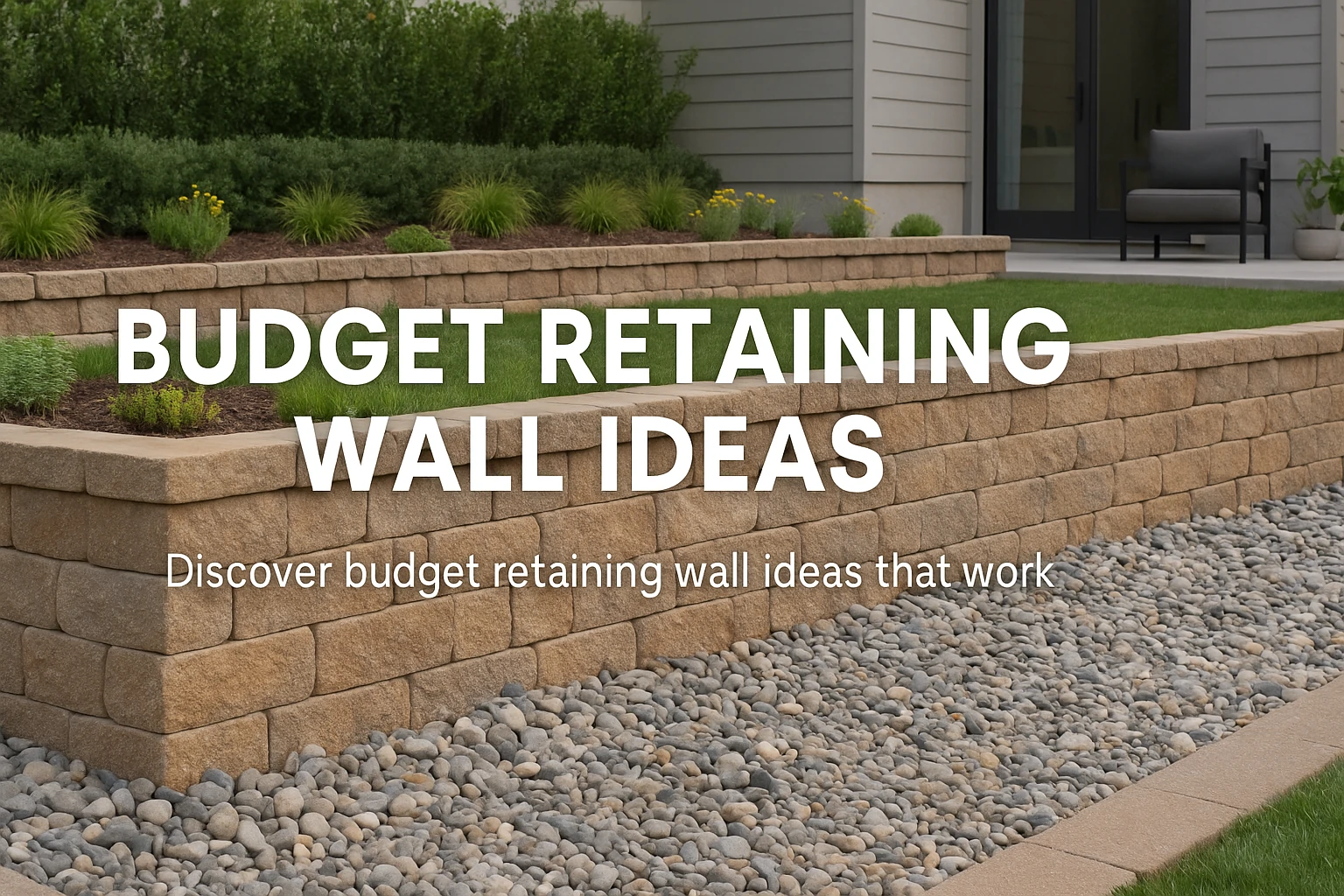Retaining walls support the land and shape the yard. They stop soil from moving and make sloped areas more useful. Many homeowners want to build one but fear the cost. Large walls made from stone or concrete can be expensive. Still, smart options exist that fit small budgets.
A wall does not need to be tall or fancy to work. Some only need to support a garden bed. Others help create flat ground on a slope. Your goal will decide the size and design. A simple plan, low-cost materials, and your own effort can cut the total cost.
You do not need new supplies. Many people use leftover wood, bricks, or stones. Others find used items through local sales or online posts. These items often work well and cost little or nothing. Wood, blocks, or broken concrete can all create a sturdy wall.
This guide shares clear ideas that anyone can try. These projects work for both renters and homeowners. You will find ways to add style and safety without spending a lot. A strong, neat wall can give your yard more purpose and help it look its best.
Use Simple Timber Walls
Wood is a low-cost way to build a wall. Landscape timbers or treated wood planks work well. You can stack them, nail them, and set them in place without heavy tools. Treated wood helps stop rot and lasts longer outside.
Look for cheap wood at salvage yards. You may also find free pieces online. Some people give away old deck wood that still works for garden walls. Use rebar or long spikes to hold the boards together. Add gravel behind the wall to help drain water.
A timber wall adds a natural look to the yard. It fits well with gardens, wooded spaces, or rustic designs. These walls stay strong for years with care. Just keep them dry and check for soft spots now and then.
Try Concrete Garden Blocks
Concrete blocks cost more than wood but still fit most budgets. Some are made just for small walls. These blocks often snap into place and need no cement. You can build a wall fast with a clean finish.
Start with a level base. Stack the blocks so the seams do not line up. This makes the wall stronger. Add gravel and drain pipes behind the wall to stop pressure from water buildup.
Many stores sell garden wall blocks in bulk. You can save money when buying more. Check with local builders or ask about damaged blocks they can’t use. Sometimes these are sold cheap or given away.
Concrete blocks come in many colors and shapes. Pick one that matches your home’s style. These walls look clean and modern and hold up well in all seasons.
Use What You Already Have
Some of the best walls come from recycled materials. Old bricks, broken pavers, or leftover concrete slabs can all work. These items often end up in trash piles. You can use them to build something new.
Urbanite is a common name for broken concrete pieces. Stack them like puzzle parts. Add soil between the cracks and plant herbs or flowers. This gives a soft look and saves money.
Mixing materials also helps. Use wood posts with stone in between. Or line up glass bottles or metal cans for small garden walls. These designs need care but cost little and make your yard one of a kind.
Before you build, plan your wall shape and test how pieces stack. A flat, firm base helps everything stay in place. Recycled walls take time but give great results.
You can also see how reused materials made a bold statement in the Look What Mom Found Fathead Wall Graphic Giveaway.
Build a Gabion Wall
Gabion walls use metal cages filled with rock or rubble. They work well on slopes and in wet areas. You can build them with wire mesh or buy ready-made baskets.
Fill the cages with cheap stones or broken bricks. Some people even use logs or glass. These walls let water drain through. They stand firm in heavy rain and last for years.
Gabions work best on strong, level ground. Stack the baskets like blocks. Tie them together with wire or zip ties. You can shape them in curves or make seats and planters from them too.
These walls cost less if you fill them with free rubble. They also look bold and modern, or natural, depending on the stone you use.
Try Plain Cinder Blocks with a New Look
Cinder blocks are cheap and strong. They build fast and hold back heavy soil. You can use them plain or dress them up with paint or plants.
Make sure the base is level. Use mortar or wall glue to hold the blocks. Add gravel and pipes behind the wall for drainage. This keeps it dry and strong.
To make the wall look better, add a face to the front. Use tile, stone veneer, or wood panels. You can also plant ivy or flowers to grow over the wall. This gives life to the space and hides the plain blocks.
This option is great if you want a strong wall that you can update later. Paint it once a year or add lights and planters.
Use Sandbags for Small Walls
Sandbags work for short walls and quick fixes. Fill them with sand, soil, or gravel. Stack them like bricks. Press each row flat before adding the next.
Sandbag walls help stop water and hold loose soil. They are easy to build and cost almost nothing. Use strong bags that resist the sun and rain.
These walls work well in gardens, flood zones, or as a base for more permanent walls. Cover them with mulch or plants to hide the bags and improve the look.
This type of wall will not last forever, but it can help in a tight spot or during a short project.
Build with Local Stone or Field Rock
If you have stone on your land, use it. A dry-stack rock wall looks classic and costs little. Stack stones without glue or cement. Fit them tight so they hold on their own.
Start with the biggest stones at the bottom. Work up from there. Add small pieces to fill gaps. This takes time but gives a strong, natural wall.
Stone walls work best when low. Use them to shape garden beds, line paths, or mark spaces in your yard. Add gravel at the base for drainage.
Each rock wall is one of a kind. You may need help lifting large pieces. Still, it gives you beauty and function with almost no cost.
Ways to Cut More Costs
Do the labor yourself if the wall is small. This saves a lot of money. Learn from video guides or visit local workshops. Ask friends or neighbors for help.
Borrow or rent tools instead of buying. Many jobs only need tools once. Check with local shops or tool libraries.
Use free materials when you can. Look on classified sites, community boards, or ask builders. Leftover blocks, bricks, or wood often go to waste.
Mix types of walls. Use stone where it shows and sandbags where it doesn’t. Use wood on the sides and blocks in the center. This cuts cost and adds style.
Plan the wall before you begin. Measure the space and mark it with string or spray. Know your slope, soil type, and drainage. A good plan avoids waste and rework.
Conclusion
You do not need a big budget to build a strong, lasting retaining wall. With smart planning and a little effort, you can shape your yard and keep soil in place. Wood, blocks, gabions, stone, and recycled items all work well.
Each option has a style and a price range. Pick one that fits your yard, your goal, and your time. Try a small wall first. Learn the process, then build more if needed.
These walls add beauty and function to your space. They help prevent erosion, shape flower beds, and create flat land for use. Best of all, they show that smart work matters more than big spending.
You can build a wall that lasts for years and still save money. Use these ideas to start your project today. Your yard will look better, and you will feel proud of what you built.



